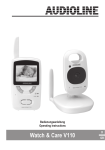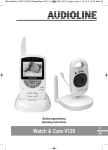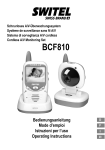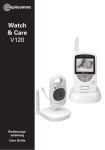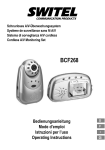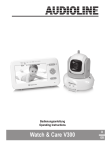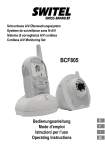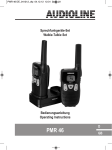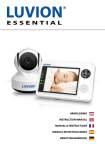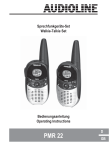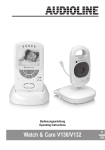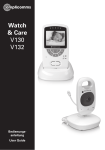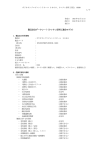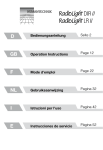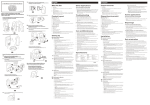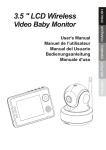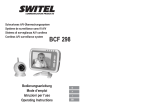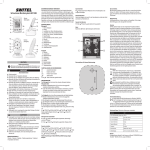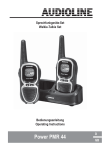Download BCF900 - Switel
Transcript
Schnurloses A/V-Überwachungssystem Système de surveillance sans fil A/V Sistema di sorveglianza A/V cordless Cordless A/V Monitoring Set BCF900 Bedienungsanleitung Mode d'emploi Istruzioni per l'uso Operating Instructions 2 Bedienungsanleitung . . . . . . . . . . . . . . . . . . . 3 Mode d'emploi . . . . . . . . . . . . . . . . . . . . . . . 18 Istruzioni per l'uso . . . . . . . . . . . . . . . . . . . . . 33 Operating Instructions . . . . . . . . . . . . . . . . . . 48 2 1 1 2 3 4 5 6 7 8 9 10 Sicherheitshinweise . . . . . . . . . . . . . . Bedienelemente und Anzeigen . . . . . . . Inbetriebnahme . . . . . . . . . . . . . . . . . . Empfänger und Sender anmelden/verbinden . . . . . . . . . . . . . Bedienung des Senders . . . . . . . . . . . . Bedienung des Empfängers . . . . . . . . . Falls es Probleme gibt . . . . . . . . . . . . . Technische Eigenschaften . . . . . . . . . . Pflegehinweise / Garantie . . . . . . . . . . Stichwortverzeichnis . . . . . . . . . . . . . . Inhaltsverzeichnis 4 6 7 9 10 12 14 15 16 17 3 Sicherheitshinweise 1 Sicherheitshinweise Lesen Sie diese Bedienungsanleitung sorgfältig durch. Bestimmungsgemäße Verwendung Das A/V-Überwachungssystem wurde zur Überwachung von Räumen entwickelt. Der Sender übermittelt von seinem Standort aus Stimmlaute und Bilder an den Empfänger. Jede andere Verwendung gilt als nicht bestimmungsgemäß. Die Verwendung des Geräts ersetzt nicht die persönliche Beaufsichtigung, z. B. eines Kindes. Der Anwender wird nicht aus seiner persönlichen Haftung entlassen. Eigenmächtige Veränderungen oder Umbauten sind nicht zulässig. Öffnen Sie das Gerät in keinem Fall selbst und führen Sie keine eigenen Reparaturversuche durch. Aufstellungsort und Sicherheitsinformationen 1. 2. 3. 4. 5. 6. 7. Legen Sie den Sender niemals in das Bett oder in den Laufstall eines Babys/Kindes. Vergewissern Sie sich, dass sich der Sender und das Netzteil immer außerhalb der Reichweite von Babys/Kindern befinden. Sorgen Sie während des Betriebs für ausreichende Belüftung aller Komponenten. Legen Sie keine Kissen, Handtücher oder Ähnliches auf die Geräte. Die Geräte sind nicht für den medizinischen Einsatz geeignet. Warn- oder Signaltöne von Atmungsoder Herztonüberwachungsgeräten können nicht übertragen werden. Der Aufstellungsort hat entscheidenden Einfluss auf den einwandfreien Betrieb. Halten Sie einen Mindestabstand von einem Meter zu elektronischen Geräten, wie z. B. Mikrowellen oder Hi-Fi-Geräten ein, da es sonst zu gegenseitiger Beeinflussung/Störung kommen kann. Vermeiden Sie Belastungen durch Rauch, Staub, Erschütterungen, Chemikalien, Feuchtigkeit, Hitze oder direkte Sonneneinstrahlung. Verwenden Sie die Geräte nicht in explosionsgefährdeten Bereichen. Netzteil Achtung: Verwenden Sie nur die mitgelieferten Netzteile, da andere Netzteile das A/V-Überwachungssystem beschädigen können. Sie dürfen den Zugang zum Netzteil nicht durch Möbel oder andere Gegenstände versperren. Achten Sie beim Betrieb mit einem Netzteil auf den einwandfreien Zustand der Kabel und Stecker. Abgeknickte oder durchgescheuerte Kabel sind lebensgefährlich! Aufladbare Akkus Achtung: Werfen Sie Akkus nicht ins Feuer. Verwenden Sie nur Akkus des gleichen Typs! Achten Sie auf die richtige Polung! Stromausfall Bei Stromausfall funktionieren die Geräte nur im Batteriebetrieb. Ziehen Sie dafür die Netzteile aus den Geräten heraus. Medizinische Geräte Achtung: Benutzen Sie die Geräte nicht in der Nähe von medizinischen Geräten. Eine Beeinflussung kann nicht völlig ausgeschlossen werden. 4 Sicherheitshinweise Entsorgung Wollen Sie Ihr Gerät entsorgen, bringen Sie es zur Sammelstelle Ihres kommunalen Entsorgungsträgers (z. B. Wertstoffhof). Nach dem Elektro- und Elektronikgerätegesetz sind Besitzer von Altgeräten gesetzlich verpflichtet, alte Elektro- und Elektronikgeräte einer getrennten Abfallerfassung zuzuführen. Das nebenstehende Symbol bedeutet, dass Sie das Gerät auf keinen Fall in den Hausmüll werfen dürfen! Gefährdung von Gesundheit und Umwelt durch Akkus und Batterien! Akkus und Batterien nie öffnen, beschädigen, verschlucken oder in die Umwelt gelangen lassen. Sie können giftige und umweltschädliche Schwermetalle enthalten. Sie sind gesetzlich verpflichtet, Akkus und Batterien beim batterievertreibenden Handel sowie bei zuständigen Sammelstellen, die entsprechende Behälter bereitstellen, sicher zu entsorgen. Die Entsorgung ist unentgeltlich. Die Symbole bedeuten, dass Sie Akkus und Batterien auf keinen Fall in den Hausmüll werfen dürfen und sie über Sammelstellen der Entsorgung zugeführt werden müssen. Verpackungsmaterialien entsorgen Sie entsprechend den lokalen Vorschriften. 5 Bedienelemente und Anzeigen 2 Bedienelemente und Anzeigen 1 2 3 4 5 6 Empfänger 8 9 10 1 1 12 13 14 15 7 16 18 Sender 19 20 21 27 22 23 24 1 2 3 4 5 6 7 8 9 10 11 12 13 14 15 16 17 18 19 20 21 22 23 24 25 26 27 28 29 30 31 32 6 17 25 28 26 31 32 Power-LED / Akkustands-LED LC-Display Melodie-Taste Mode-Taste Sprech-Taste (+/–)-Taste Mikrofon LCD-Schalter OFF/LCD OFF/ON (EIN/ LCD AUS/ AUS) ALARM ON/OFF (Alarm EIN/AUS) CHANNEL-Taste Lautsprecher ausklappbarer Standfuß Akkufachfach AV-Output 6 V-Stromversorgungsbuchse Ladestation Ladekontakte Lade-LED Power-LED Drehring zur Objektivverdrehung Infrarot-LEDs für die Nachtüberwachung Objektiv Lautsprecher Mikrofon 6 V-Stromversorgungsbuchse Nachtlicht Batteriefach VOLUME Hi/ Mid/ Lo (Lautstärke Laut/ Mittel/ Leise) Geräuschaktivierungs-Schalter CAMERA/AUTO NIGHTLIGHT AUTO/ON/OFF (Nachtlicht-Schalter AUS/ AUTO/ AN) ECO- Modusschalter Hi/ Lo (Hoch/ Niedrig) Power-Taste 29 32 Inbetriebnahme 3 Inbetriebnahme Sicherheitshinweise Achtung: Lesen Sie vor der Inbetriebnahme unbedingt die Sicherheitshinweise in Kapitel 1. Die übertragenen Daten (Bild und/oder Töne) werden im Empfangsbereich öffentlich übertragen! Verpackungsinhalt prüfen 2 Zum Lieferumfang gehören: ein Sender ein Empfänger ein Lithium Ion Akku 3,7 V 1200 mA zwei Netzteile eine Ladestation eine Bedienungsanleitung Sender anschließen Achtung: Stellen Sie den Sender mit einem Mindestabstand von 1 m zu anderen elektronischen Geräten auf, da es sonst zu gegenseitigen Störungen kommen kann. Betrieb mit Netzteil Achtung: Verwenden Sie nur das mitgelieferte Netzteil. Sie dürfen den Zugang zum Steckernetzteil nicht durch Möbel oder andere Gegenstände versperren. Schließen Sie den Sender wie auf der Skizze abgebildet an. Netzsteckdose 7 Inbetriebnahme Betrieb mit Batterien Lösen Sie die Schrauben auf der Rückseite des Senders und entfernen die Batteriefachabdeckung. Legen Sie vier Batterien des Typs Alkaline AA 1,5 V (nicht im Lieferumfang enthalten) polrichtig in das Batteriefach ein und schließen Sie das Batteriefach. 3 Hi Lo HiMid Lo OFF AUTO ON Empfänger anschließen Achtung: Stellen Sie den Empfänger mit einem Mindestabstand von 1 m zu anderen elektronischen Geräten auf, da es sonst zu gegenseitigen Störungen kommen kann. Betrieb mit Netzteil Schließen Sie die Ladestation des Empfängers wie auf der Skizze abgebildet an. Verwenden Sie aus Sicherheitsgründen nur das mitgelieferte Netzteil. Netzsteckdose Achtung: Verwenden Sie nur das mitgelieferte Netzteil. Sie dürfen den Zugang zum Steckernetzteil nicht durch Möbel oder andere Gegenstände versperren. Betrieb mit Akku Lösen Sie die Schrauben auf der Rückseite des Empfängers und entfernen die Akkufachabdeckung. Legen Sie den Akku polrichtig in das Akkufach ein und schließen Sie das Akkufach. Der Empfänger wird mit einem Lithium Ion Akku geliefert (3,7 V, 1200 mA). 8 Empfänger und Sender anmelden/verbinden 4 Empfänger und Sender anmelden/verbinden 4 Empfänger und Sender sind bei Auslieferung bereits angemeldet. Bei Bedarf können Sie eine Anmeldung auch manuell durchführen: 1. Halten Sie die Channel-Taste (10) Senderrückseite Empfänger auf der Rückseite des Empfängers (aufgeklappt) und die Mode-Taste (4) gleichzeitig 4 gedrückt. 2. Es erscheint ein Menü auf dem 6 Code LC-Display, in dem Sie mit der 10 Channel-Taste (10) vertikal und mit den (+/-)-Tasten (6) horizontal navigieren. Wählen Sie mit der Channel-Taste (10) z.B. CH 1, mit den (+/-)-Tasten (6) “Pair”. 3. Bestätigen Sie mit der Mode-Taste (4). “Pairing” erscheint im LC-Display. 4. Drücken Sie die Code-Taste auf der Rückseite des Senders. Die Power-LED am Sender blinkt auf. 5. Das Display zeigt: Pairing succeed und den gewählten Kanal. 6. Bestätigen Sie mit der Channel-Taste (10). Sie gelangen zurück zum Kamerabild. Wenn Sie mehrere Sender zur Verfügung haben, müssen Sie im Menü die unterschiedlichen Kanäle (CH1 - CH4) einzeln anwählen und die Code-Taste an jedem Sender betätigen. Der Empfänger unterstützt bis zu vier Sender. 9 Bedienung des Senders 5 Bedienung des Senders Überprüfen Sie vor jedem Einsatz die einwandfreie Funktion von Sender und Empfänger. Sender ein-/ausschalten 1. Tippen Sie die Power-Taste (33) kurz an. Die Power-LED (19) leuchtet grün. Der Sender ist betriebsbereit. 2. Zum Ausschalten des Senders halten Sie die Power-Taste (33) für ca. 2 Sekunden gedrückt. Geräuschaktivierte Übertragung In der Stellung des Geräuschaktivierungs-Schalters (30) “CAMERA” werden Bild und Ton dauerhaft übertragen. In der Stellung “AUTO” werden Bild und Ton ab ca. 50 dB übertragen. Bei der Übertragung tritt eine kurze Verzögerung auf, bevor der Empfänger die Stimme/das Geräusch und das Bild wiedergibt. Wenn länger als 30 Sek. keine Stimme oder kein Geräusch mehr erkannt wurde, wird die Übertragung automatisch beendet. Nachtsichtfunktion Die integrierte Infrarot-Technik erlaubt eine Bildübertragung aus unbeleuchteten Bereichen. Die Nachtsichtfunktion wird automatisch aktiviert, wenn die Lichtverhältnisse es erfordern. Bei aktivierter Nachtsichtfunktion ist die Darstellung auf dem LC-Display am Empfänger schwarz-weiß. Der Aufnahmebereich beträgt ca. 2 m. 10 Bedienung des Senders Nachtlicht y y y Das Nachtlicht kann dauerhaft oder automatisch bei Geräuscherkennung ab ca. 50 dB eingeschaltet werden. Schalten Sie den NIGHTLIGHT-Schalter (31) in die Position “ON”. Das Nachtlicht ist dauerhaft eingeschaltet. Schalten Sie den NIGHTLIGHT-Schalter (31) in die Position “OFF”. Das Nachtlicht ist ausgeschaltet. Schalten Sie den NIGHTLIGHT-Schalter (31) in die Position “AUTO”. Bei einem Geräuschpegel ab ca. 50 dB wird das Nachtlicht automatisch eingeschaltet. Kamerabild horizontal drehen Sie können das übertragene Bild der Kamera horizontal verdrehen, indem Sie den Drehring zur Objektivverdrehung (20) nach links oder rechts drehen. ECO-Modus Ihr Sender verfügt über einen ECO-Modus der beim Betrieb mit Batterien sehr nützlich sein kann. Er verringert die Sendeleistung, verlängert aber die Lebensdauer der Batterien. Sie aktivieren Ihn indem Sie den ECO-Modusschalter (32) auf “LO“ schalten. Achtung: Die Verbindungsreichweite des Senders verringert sich bei aktiven ECO-Modus. Dies kann zu Störungen in der Übertragung führen. In diesem Fall sollten Sie neue Standorte für die Geräte wählen oder den ECO-Modus deaktivieren. Lautsprecherlautstärke ändern Sie können die Lautstärke des Senders mit dem Lautstärkeregler (29) auf drei Stufen verstellen. 11 Bedienung des Empfängers 6 Bedienung des Empfängers Überprüfen Sie vor jedem Einsatz die einwandfreie Funktion von Sender und Empfänger. Empfänger ein-/ausschalten Der LCD-Schalter (8) an der Seite des Empfängers hat drei Stellungen: y “OFF”- Das Gerät ist komplett ausgeschaltet. y “LCD OFF”- Das Gerät gibt nur den empfangenen Ton wieder. Das Display ist ausgeschaltet. y ”ON”- Das Gerät gibt Bild und Ton wieder. Lautstärke einstellen y y Drücken Sie die (+)-Taste (6), um die Lautstärke zu erhöhen. Drücken Sie die (-)-Taste (6), um die Lautstärke zu verringern. Helligkeit einstellen y Drücken Sie einmal die Mode-Taste. y Drücken Sie die (+)-Taste (6), um die Helligkeit zu erhöhen. y Drücken Sie die (-)-Taste (6), um die Helligkeit zu verringern. Stellen Sie die gewünschte Helligkeit ein. Kontrast einstellen y Drücken Sie zweimal die Mode-Taste. y Drücken Sie die (+)-Taste (6), um den Kontrast zu erhöhen. y Drücken Sie die (-)-Taste (6), um den Kontrast zu verringern. Stellen Sie den gewünschten Kontrast ein. Farbe einstellen y Drücken Sie dreimal die Mode-Taste. y Drücken Sie die (+)-Taste (6), um die Farbsättigung zu erhöhen. y Drücken Sie die (-)-Taste (6), um die Farbsättigung zu verringern. Stellen Sie die gewünschte Farbe ein. 12 Bedienung des Empfängers Sprachübertragung starten Sie können von Ihrem Empfänger aus eine Sprachübertragung zum Sender starten. Ihre Stimme wird dann vom Lautsprecher im Sender wiedergegeben. Halten Sie die Sprech-Taste (5) gedrückt und sprechen Sie in das Mikrofon (7) des Empfängers. Die Übertragung wird beendet, wenn Sie die Sprech-Taste (5) wieder loslassen. Während Sie die Sprech-Taste (5) gedrückt halten wird die Tonübertragung vom Sender zum Empfänger unterbrochen. Melodien Sie können über den Empfänger Melodien am Sender wiedergeben lassen. Sie haben 3 verschiedene Melodien zur Auswahl. Drücken Sie die Melodie-Taste (3). Die erste Melodie wird abgespielt. Durch erneutes Drücken der Melodie-Taste (3) wird die nächste Melodie gespielt. Kanalwahl Die Kanalwahl ist werkseitig auf Kanal 1 voreingestellt. Das BCF900 ist in der Lage, 4 Sender für einen Empfänger an 4 verschiedenen Standorten zu nutzen. Dazu benutzen Sie die CHANNEL-Taste (10). (Siehe Seite 8 für Informationen über die Verwendung von mehreren Sendern.) Power-LED / Akkustand-LED Die Power-LED (1) (grün) ist gleichzeitig Akkustand-LED. Sie blinkt orange, wenn der Akku geladen werden muss. 13 Falls es Probleme gibt 7 Falls es Probleme gibt Service-Hotline Haben Sie Probleme mit Ihrem A/V-Überwachungssystem BCF900, kontrollieren Sie zuerst die folgenden Hinweise. Bei technischen Problemen können Sie sich an unsere Service-Hotline unter Tel. 0900 00 1675 innerhalb der Schweiz (Kosten Swisscom bei Drucklegung: CHF 2.60/min) wenden. Bei Garantieansprüchen wenden Sie sich an Ihren Fachhändler. Die Garantiezeit beträgt 2 Jahre. Fragen und Antworten Fragen Antworten Keine Funktion - Sender und/oder Empfänger sind nicht eingeschaltet. - Der Akku ist leer oder defekt. - Netzteile sind nicht korrekt angeschlossen. Kein Empfang - Sender und Empfänger sind nicht angemeldet. - Der Abstand des Senders, z. B. zum Baby, ist zu groß. Beachten Sie den Mindestabstand von einem Meter. - Der Abstand zwischen Empfänger und Sender ist zu groß. Empfangsstörungen - Der Abstand zwischen Sender und Empfänger ist zu groß. - Die Akkuleistung ist zu gering. - Andere elektronische Geräte stören das Übertragungsfeld. Pfeifton (Rückkopplung) - Vergrößern Sie die Entfernung zwischen Sender und Empfänger. - Verringern Sie die Lautstärke am Empfänger. Rauschen - Die Akkuleistung ist zu gering. Bild- aber keine Tonübertra- - Die Lautstärke ist zu gering eingestellt. gung 14 Bild wird schwarz-weiß dargestellt - Die Nachtsichtfunktion ist aktiv. Der Akku im Empfänger wird nicht geladen - Das Netzteil ist nicht richtig angeschlossen. Technische Eigenschaften 8 Technische Eigenschaften Technische Daten Merkmal Wert Sender Taste: Schalter: Buchse: Sensor: LED: Empfänger LC-Display: Schalter: Buchse: Tasten: LED: Empfänger Netzteil Eingang: Ausgang: Akku: Sender Netzteil Eingang: Ausgang: POWER: OFF/ON CAMERA/AUTO NIGHT LIGHT : OFF/AUTO/ON ALARM: OFF/ON VOLUME: (Hi/Mid/Lo) Eco-Modus: (Hi/Lo) 6 VDC 1 Nachtlichtsensor Verbindung/Power 3,5” TFT LC-Farb-Display LCD: OFF/LCD OFF/ON 6 VDC Sprechen, Melodie, Mode, Lautstärke (+/-) Power 100-240 VAC, 50-60 Hz, 150 mA 6 V DC, 800 mA Lithium Ion 3,7 V 1200 mA 100-240 VAC, 50-60 Hz , 150 mA 6 V DC, 800 mA Reichweite Bis zu 300 Metern unter optimalen Bedingungen. In Gebäuden wird die Reichweite durch Wände, Türen usw. verringert. Frequenzbereich 2400 MHz Zulässige Umgebungstemperatur 0° C bis 40° C Zulässige relative Luftfeuchtigkeit 20 % bis 75 % Sendeleistung (TX PA Power) 13 ± 1 dBm Konformitätserklärung Dieses Gerät erfüllt die Anforderungen der EU-Richtlinie: 1999/5/EG Richtlinie über Funkanlagen und Telekommunikationsendeinrichtungen und die gegenseitige Anerkennung ihrer Konformität. Die Konformität mit der o. a. Richtlinie wird durch das CE-Zeichen auf dem Gerät bestätigt. Für die komplette Konformitätserklärung nutzen Sie bitte den kostenlosen Download von unserer Website www.switel.com. 15 Pflegehinweise / Garantie 9 Pflegehinweise / Garantie Pflegehinweise S S Reinigen Sie die Gehäuseoberflächen mit einem weichen und fusselfreien Tuch. Verwenden Sie keine Reinigungsmittel oder Lösungsmittel. Garantie SWITEL - Geräte werden nach den modernsten Produktionsverfahren hergestellt und geprüft. Ausgesuchte Materialien und hoch entwickelte Technologien sorgen für einwandfreie Funktion und lange Lebensdauer. Die Garantie gilt nicht für die in den Produkten verwendeten Batterien, Akkus oder Akkupacks. Die Garantiezeit beträgt 24 Monate, gerechnet vom Tage des Kaufs. Innerhalb der Garantiezeit werden alle Mängel, die auf Material- oder Herstellungsfehler zurückzuführen sind, kostenlos beseitigt. Der Garantieanspruch erlischt bei Eingriffen durch den Käufer oder durch Dritte. Schäden, die durch unsachgemäße Behandlung oder Bedienung, natürliche Abnutzung, durch falsches Aufstellen oder Aufbewahren, durch unsachgemäßen Anschluss oder Installation sowie durch höhere Gewalt oder sonstige äußere Einflüsse entstehen, fallen nicht unter die Garantieleistung. Wir behalten uns vor, bei Reklamationen die defekten Teile auszubessern, zu ersetzen oder das Gerät auszutauschen. Ausgetauschte Teile oder ausgetauschte Geräte gehen in unser Eigentum über. Schadenersatzansprüche sind ausgeschlossen, soweit sie nicht auf Vorsatz oder grober Fahrlässigkeit des Herstellers beruhen. Sollte Ihr Gerät dennoch einen Defekt innerhalb der Garantiezeit aufweisen, wenden Sie sich bitte unter Vorlage Ihrer Kaufquittung ausschließlich an das Geschäft, in dem Sie Ihr SWITEL - Gerät gekauft haben. Alle Gewährleistungsansprüche nach diesen Bestimmungen sind ausschließlich gegenüber Ihrem Fachhändler geltend zu machen. Nach Ablauf von zwei Jahren nach Kauf und Übergabe unserer Produkte können Gewährleistungsrechte nicht mehr geltend gemacht werden. Wichtiger Hinweis Ihr Gerät verfügt über energie-effiziente Schaltnetzteile (Eingangsspannung 240 VAC, Ausgangsspannung 6 VDC, 800 mA). Die Leistungsaufnahme des Adapters (Empfänger) ohne Last beträgt ca. 0,3 W. Der durchschnittliche Wirkungsgrad beträgt ca. 72,02 %. Der Stromverbrauch während der Nutzung beträgt ca. 2,9 W, während des Ladevorgangs ca. 2,1 W und ca. 0,149 W während des Stand-by Betriebes. Die Leistungsaufnahme des Adapters (Sender) ohne Last beträgt ca. 0,3 W. Der durchschnittliche Wirkungsgrad beträgt ca. 72,02 %. Der Stromverbrauch während beträgt der Nutzung ca. 2,9 W und ca. 0,143 W während des Stand-by Betriebes. 16 Stichwortverzeichnis 10 Stichwortverzeichnis A Anmelden, 10 B Bedienelemente, 7 Bedienung, 11, 13 Betrieb mit Akku, 9 Betrieb mit Netzteil, 8, 9 E ECO-Modus, 12 Empfänger anschließen, 9 Empfänger ein-/ausschalten, 13 F Farbe einstellen, 13 Fehlerbehebung, 15 Fragen und Antworten, 15 G Garantie, 18 Geräuschaktivierte Übertragung, 11 H Helligkeit einstellen, 13 I Inbetriebnahme, 8 L Lautsprecherlautstärke ändern, 12 Lautstärke einstellen, 13 N Nachtlicht, 12 Nachtsichtfunktion, 11 P Pflegehinweise, 18 Power-LED / Akkuzustands-LED, 14 Probleme, 15 S Schlaflieder, 14 Sender anschließen, 8 Sender ein-/ausschalten, 11 Service-Hotline, 15 Sicherheitshinweise, 5 Sprachübertragung starten , 14 T Technische Daten, 16 V Verbindung herstellen, 10 Verpackungsinhalt, 8 K Kamerabild horizontal drehen, 12 Kanalwahl, 14 Konformitätserklärung, 17 Kontrast einstellen, 13 17 5 Table des matières 1 Consignes de sécurité . . . . . . . . . . . . . 2 Éléments de manipulation et affichages . 3 Mise en service . . . . . . . . . . . . . . . . . . 4 Déclarer/Connecter le récepteur et l'émetteur . . . . . . . . . . . . . . . . . . 5 Utilisation de l'émetteur . . . . . . . . . . . . 6 Utilisation du récepteur . . . . . . . . . . . . 7 En cas de problèmes . . . . . . . . . . . . . . 8 Caractéristiques techniques . . . . . . . . . 9 Remarques d'entretien / Garantie . . . . . 18 19 21 22 24 25 27 29 30 31 Consignes de sécurité 1 Consignes de sécurité Lisez très attentivement ce mode d'emploi. Utilisation du babyphone conformément à son usage Le système de surveillance A/V a été conçu pour la surveillance de pièces. Depuis sa position, l'émetteur transmet des voix et des images au récepteur. Toute autre utilisation est considérée comme non conforme à son usage. L'utilisation de cet appareil ne remplace pas la surveillance personnelle, d'un enfant p. ex. L'utilisateur n'est pas dégagé de son obligation personnelle. Des modifications ou changements arbitraires sont interdits. N'ouvrez en aucun cas l'appareil ni ne tentez de le réparer vous-même. Lieu d'installation et informations de sécurité 1 2. 3 4 5 6 7 Ne déposez jamais l'émetteur dans le lit ou dans le parc d'un bébé/d'un enfant. Assurez-vous que l'émetteur ou le bloc secteur se trouvent toujours hors de portée de bébés/ d'enfants. Pendant le fonctionnement des appareils, veillez à une aération suffisante de tous leurs composants. Ne posez pas de coussins, de serviettes éponge ou d'autres choses semblables dessus. Les appareils ne conviennent pas pour une utilisation médicale. Des signaux d'avertissement ou sonores d'appareils respiratoires ou de surveillance des bruits du cœur ne peuvent pas être transmis. Le lieu d'installation a une influence décisive sur leur parfait fonctionnement. Respectez une distance d'au moins un mètre par rapport à des équipements électroniques tels que microondes ou appareils HIFI, les appareils pouvant s'influencer/se perturber réciproquement. Evitez toute nuisance par la fumée, la poussière, les vibrations, les produits chimiques, l'humidité, la grande chaleur ou l'ensoleillement direct. N'utilisez pas les appareils dans des pièces exposées aux explosions. Bloc secteur Attention : N'utilisez que les blocs secteur enfichables fournis avec l'appareil, d'autres blocs pouvant endommager le système de surveillance A/V. Vous ne devez pas bloquer l'accès de ce dernier par des meubles ou d'autres objets. En cas de fonctionnement avec un bloc d'alimentation, veiller à ce que l'état des câbles et des fiches soit irréprochable. Des câbles pliés ou usés par frottement présentent un danger de mort ! Piles rechargeables Attention : Ne jetez pas les piles rechargeables dans le feu. N'utilisez que des piles du même type ! Observez une polarisation correcte ! Panne de courant En cas de panne de courant, les appareils fonctionnent uniquement avec une alimentation par pile. Retirez alors les blocs secteur des appareils. Appareils médicaux Attention : N'utilisez pas les appareils à proximité d'appareils médicaux. Leur influence sur ce genre d'appareils ne peut pas être entièrement exclue. 19 Consignes de sécurité Élimination Si vous voulez vous séparer de votre appareil, veuillez l'apporter au centre de collecte de l'organisme d'élimination des déchets de votre commune (par ex. centre de recyclage). D'après la loi relative aux appareils électriques et électroniques, les propriétaires d'appareils usagés sont tenus de mettre tous les appareils électriques et électroniques usagés dans un collecteur séparé. L'icône ci-contre signifie que vous ne devez en aucun cas jeter votre appareil dans les ordures ménagères ! Mise en danger de l'homme et de l'environnement causées par les piles et piles rechargeables ! Ne jamais ouvrir, endommager, avaler les piles rechargeables et les piles ou ne jamais faire pénétrer leur contenu dans l'environnement. Elles peuvent contenir des métaux lourds toxiques qui le polluent. Vous êtes tenus par la loi d'éliminer vos piles rechargeables et piles auprès d'un revendeur de piles et piles ainsi qu'auprès de centres de collecte responsables de leur élimination, qui mettent des conteneurs adéquats à disposition. L'élimination des piles est gratuite. L'icône ci-contre signifie que vous ne devez en aucun cas jeter les piles rechargeables et piles dans les ordures ménagères, mais que vous devez les éliminer auprès de centres de collecte. Éliminez les fournitures d'emballage conformément au règlement local. 20 Éléments de manipulation et affichages 2 Éléments de manipulation et affichages 1 2 3 4 5 6 Récepteur 8 9 10 1 1 12 13 14 15 7 16 18 Émetteur 19 20 21 27 22 23 24 1 2 3 4 5 6 7 8 9 10 11 12 13 14 15 16 17 18 19 20 21 22 23 24 25 26 27 28 29 30 31 32 17 25 28 26 31 32 29 32 LED Power / LED niveau de charge des piles Écran à cristaux liquides Touche mélodie Touche mode Touche vocale Touche (+/–) Microphone Interrupteur LCD OFF/LCD OFF/ON (ALLUMÉ/ LCD ÉTEINT/ ÉTEINT) ALARME ON/OFF (Alarme ALLUMÉE/ÉTEINTE) Touche canal Haut-parleur Support escamotable Cache compartiment pile Sortie AV Prise d'alimentation 6 V Station d'accueil Contacts de chargement DEL Charge LED Power Bague tournante pour l'orientation de l'objectif LEDs à infrarouge pour la surveillance nocturne Objectif Haut-parleur Microphone Prise d'alimentation 6 V Veilleuse Compartiment à piles VOLUME Hi/ Mid/ Lo (volume sonore fort/ moyen/ faible) Interrupteur d'activation des bruits CAMÉRA/AUTO NIGHTLIGHT AUTO/ON/OFF (Interrupteur de veilleuse DÉSACTIVÉ/ AUTO/ ACTIVÉ) Interrupteur de mode ECO Hi/ Lo (haut / bas) Touche Power 21 Mise en service 3 Mise en service Consignes de sécurité Attention : Avant de mettre vos appareils en service, lisez impérativement les consignes de sécurité mentionnées au chapitre 1. Les données transmises (image) et/ou voix sont reçues publiquement dans la zone desservie ! Vérifier le contenu du coffret 6 Contenu du coffret : un émetteur un récepteur une pile rechargeable Lithium Ion 3,7 V 1200 mA deux blocs d'alimentation une station d'accueil un mode d'emploi Raccorder l'émetteur Attention : Posez l'émetteur à une distance minimum d'un mètre par rapportaux autres équipements électroniques pour éviter d'éventuelles interactions. Fonctionnement par le bloc d'alimentation Attention : N'utilisez que le bloc secteur enfichable fourni avec les appareils. Vous ne devez pas en bloquer l'accès par des meubles ou d'autres objets. Raccordez l'émetteur comme représenté sur le croquis. Prise réseau 22 Mise en service Marche avec piles Desserrez les vis situés à l'arrière de l'émetteur et retirez le cache-piles. Insérez quatre piles de type alcaline AA 1,5 V (non vendues avec) dans le compartiment prévu à cet effet en prenant soin de respecter la polarité correcte et refermer le compartiment. 7 Hi Lo HiMid Lo OFF AUTO ON Raccorder le récepteur Attention : Posez le récepteur à une distance minimum d'un mètre par rapport aux autres équipements électroniques pour éviter d'éventuelles interactions. Fonctionnement par le bloc d'alimentation Raccordez la station d'accueil du récepteur comme représenté sur le croquis. Pour des questions de sécurité, n'utilisez que le bloc secteur vendu avec l'appareil. Prise réseau Attention : N'utilisez que le bloc secteur enfichable fourni avec les appareils. Vous ne devez pas en bloquer l'accès par des meubles ou d'autres objets. Fonctionnement avec pile rechargeable Desserrez les vis situés à l'arrière du récepteur et retirez le cache-piles. Insérez la pile dans le compartiment prévu à cet effet en prenant soin de respecter la polarité correcte et refermer le compartiment. Le récepteur est vendu avec une pile rechargeable Lithium Ion (3,7 V, 1200 mA). 23 Déclarer/Connecter le récepteur et l'émetteur 4 Déclarer/Connecter le récepteur et l'émetteur 8 Le récepteur et l'émetteur sont déjà déclarés lorsque vous les achetez. Au besoin, vous pouvez les déclarer manuellement : 3. Appuyez en même temps sur la Côté arrière de l'émetteur Récepteur touche canal (10) située à l'arrière (ouvert) du récepteur et sur la touche 4 mode (4). 4. Un menu s'affiche sur l'écran LCD 6 Code dans lequel vous naviguez 10 verticalement avec la touche canal (10) et horizontalement avec les touches (+/-) (6). Sélectionnez p. ex. CH 1 avec la touche canal (10) et “Pair” avec les touches (+/-) (6) 5. Validez avec la touche mode (4). “Pairing” s'affiche à l'écran. 6. Appuyez sur la touche code située à l'arrière de l'émetteur. La LED Power de l'émetteur clignote. 7. L'écran affiche : Pairing succeed ainsi que le canal sélectionné. 8. Validez avec la touche canal (10). Vous revenez à la photo. Si vous disposez de plusieurs émetteurs, vous devez sélectionner les canaux (CH1-CH4) individuellement dans le menu et appuyer sur la touche code de chaque émetteur. Le récepteur supporte quatre émetteurs au maximum. 24 Utilisation de l'émetteur 5 Utilisation de l'émetteur Avant chaque utilisation, veuillez vous assurez que l'émetteur et le récepteur fonctionnent de façon irréprochable. Allumer/Éteindre l'émetteur 1. Appuyez légèrement sur la touche Power (32). La LED Power (19) devient verte. L'émetteur est maintenant prêt à fonctionner. 2. Appuyez env. 2 secondes sur la touche Power (32) pour éteindre l'émetteur. Transmission activée par le bruit À la position de l'interrupteur activation des bruits “CAMÉRA" (29), les bruits et l'image sont transmis en permanence. En position “AUTO” bruits et image sont transmis à partir de 50 dB. Lors de la transmission, le récepteur redonne la voix/le bruit et l'image avec un léger retard. Si le système n'a plus reconnu de voix ou de bruit pendant plus de trente secondes, la transmission est automatiquement terminée. Fonction vue nocturne La caméra infrarouge intégrée permet une transmission de l'image depuis des espaces non éclairés. La fonction vue nocturne est automatiquement activée si la luminosité le requiert. Si la fonction vue nocturne est activée, la représentation sur l'écran du récepteur est en noir et blanc. L'espace de transmission est d'env. 2 m. 25 Utilisation de l'émetteur Veilleuse y y y Vous pouvez allumer la veilleuse en permanence ou automatiquement à partir d'un niveau sonore de 50 dB. Positionnez l'interrupteur veilleuse (30) sur “ON". La veilleuse est allumée en permanence. Positionnez l'interrupteur veilleuse (30) sur “OFF". La veilleuse s'éteint. Positionnez l'interrupteur veilleuse (30) sur “AUTO". La veilleuse s'allume automatiquement à partir d'un niveau sonore d'env. 50 dB. Tourner l'image de la caméra à l'horizontale Vous pouvez tourner l'image transmise de la caméra à l'horizontale en tournant vers la gauche ou la droite la bague permettant de faire pivoter l'objectif (20). Mode ECO Votre émetteur dispose d'un mode ECO très utile si vous le faites marcher sur piles. Il diminue la puissance d'émission, prolonge en revanche la durée de vie des piles. Vous activez ce mode en positionnant l'interrupteur de mode ECO (31) sur “LO“. Attention : La portée de connexion de l'émetteur diminue si le mode ECO estactivé. Ceci peut entraîner des perturbations de transmission. Dans ce cas il est conseillé de choisir un autre endroit pour les appareils ou de désactiver le mode ECO. Modifier le volume sonore du haut-parleur Le régulateur de volume vous permet de régler le volume de l'émetteur (29) sur trois niveaux. 26 Utilisation du récepteur 6 Utilisation du récepteur Avant chaque utilisation, veuillez vous assurez que l'émetteur et le récepteur fonctionnent de façon irréprochable. Allumer/Éteindre le récepteur L'interrupteur de l'écran (8) situé sur le côté du récepteur a trois positions : y “OFF”- l'appareil est complètement éteint. y “LCD OFF”- l'appareil ne reproduit que les sons reçus. L'écran est éteint. y ”ON”- l'appareil reproduit image et sons. Régler le volume sonore y y Appuyez sur la touche (+) (6) pour augmenter le volume. Appuyez sur la touche (-) (6) pour diminuer le volume. Régler la luminosité y Appuyez une fois sur la touche mode. y Appuyez une fois sur la touche (+) (6) pour augmenter la luminosité. y Appuyez une fois sur la touche (-) (6) pour diminuer la luminosité. Réglez la luminosité voulue. Régler le contraste y Appuyez deux fois sur la touche mode. y Appuyez sur la touche (+) (6) pour augmenter le contraste. y Appuyez sur la touche (-) (6) pour diminuer le contraste. Réglez le contraste voulu. Régler la couleur y Appuyez trois fois sur la touche mode. y Appuyez sur la touche (+) (6) pour augmenter la saturation de la couleur. y Appuyez sur la touche (-) (6) pour diminuer la saturation de la couleur. Réglez la couleur voulue. 27 Utilisation du récepteur Démarrer la transmission vocale Vous pouvez démarrer une transmission vocale à l'émetteur depuis votre récepteur. Votre voix est alors reproduite par le haut-parleur de l'émetteur. Appuyez un temps long sur la touche vocale (5) et parlez dans le microphone (7) du récepteur. Vous terminez la transmission en relâchant la touche vocale (5). Quand vous appuyez un temps long sur la touche vocale (5), la transmission du son de l'émetteur au récepteur est interrompue. Mélodies Le récepteur vous permet de reproduire des mélodies sur l'émetteur. Vous disposez de trois mélodies différentes. Appuyez sur la touche mélodie (3). La première mélodie est reproduite. Vous écoutez la mélodie suivante en appuyant une nouvelle fois sur la touche mélodie (3). Choix du canal La sélection du canal est préréglée sur canal 1. Le BCF900 est en mesure d'utiliser 4 émetteurs pour un récepteur à 4 endroits différents. Utilisez la touche canal (10) à cet effet. (Voir page 8 pour de plus amples informations concernant l'utilisation de plusieurs émetteurs.) LED Power / LED État de la pile La LED Power (1) (verte) est en même temps la LED pour indiquer l'état de la pile. Elle clignote orange lorsque la pile doit être rechargée. 28 En cas de problèmes 7 En cas de problèmes Hotline de service Si vous avez des problèmes avec votre appareil de surveillance A/V BCF900, contrôlez d'abord les remarques suivantes. En cas de problèmes techniques, vous pouvez également vous adresser à notre hotline de service au numéro de tél. 0900 00 1675 en Suisse (frais Swisscom lors de l'impression de ce manuel : CHF 2.60/min). Si vous avez des droits de garantie, adressez-vous à votre revendeur. La durée de la garantie est de 2 ans. Questions et réponses Questions Réponses Pas de fonction - Émetteur et/ou récepteur non branché. - La pile est vide ou défectueuse. - Les blocs secteur ne sont pas raccordés correctement. Pas de réception - Récepteur et émetteur ne sont pas déclarés. - La distance de l'émetteur, par rapport au bébé p. ex., est trop grande. Respectez la distance minimum d'un mètre. - La distance entre le récepteur et l'émetteur est trop grande. Perturbations dans la récep- - La distance entre le récepteur et l'émetteur est trop grande. tion - La puissance de la pile est trop faible. - D'autres équipements électroniques perturbent le champ de transmission. Sifflement (rétroaction) - Augmentez la distance entre le récepteur et l'émetteur. - Diminuez le volume du récepteur. Grésillements - La puissance de la pile est trop faible. Transmission de l'image mais pas du son - Le volume est trop faible. L'image est reproduite en noir et blanc - La fonction vue nocturne est active. La pile rechargeable du récepteur ne se recharge pas - Le bloc secteur n'est pas raccordé correctement. 29 Caractéristiques techniques 8 Caractéristiques techniques Données techniques Caractéristique Valeur Émetteur Touche : Interrupteur : Prise : Détecteur : LED : Récepteur Écran : Interrupteur : Prise : Touches : LED : Récepteur Bloc secteur Entrée : Sortie : Pile rechargeable : Émetteur Bloc secteur Entrée : Sortie : POWER : OFF/ON CAMERA/AUTO NIGHT LIGHT : OFF/AUTO/ON ALARME : OFF/ON VOLUME : (Hi/Mid/Lo) Mode ECO : (Hi/Lo) 6 VDC 1 détecteur de vue nocturne Connexion/Power 3,5” TFT LCD couleur LCD: OFF/LCD OFF/ON 6 VDC voix, mélodie, mode, volume sonore (+/-) Power 100-240 VAC, 50-60 Hz , 150 mA 6 V DC, 800 mA Lithium Ion 3,7 V,1200 mA 100-240 VAC, 50-60 Hz , 150 mA 6 V DC, 800 mA Portée Jusqu'à 300 mètres dans des conditions optimales. Dans des bâtiments, la portée est diminuée par les parois, les portes, etc.... Zone de fréquences 2400 MHz Température ambiante autorisée 0°C à 40°C Humidité atmosphérique relative autorisée 20% à 75% Puissance d'émission (TX PA Power) 13 ± 1 dBm Déclaration de conformité Cet appareil répond aux exigences des directives de l'union européenne (UE) : 1999/5/CE Directive sur les installations de radio et de télécommunication et la reconnaissance réciproque de leur conformité. La conformité avec la directive mentionnée ci-dessus est confirmée par la marque CE apposée sur l'appareil. Pour obtenir la déclaration intégrale de conformité, veuillez vous servir du téléchargement gratuit sur notre site Internet www.switel.com. 30 Remarques d'entretien / Garantie 9 Remarques d'entretien / Garantie Remarques d'entretien S S Nettoyez les surfaces du boîtier avec un chiffon doux et non pelucheux. N'utilisez pas de produits d'entretien ou de solvants. Garantie Les appareils SWITEL sont fabriqués et testés selon les procédés de production de pointe. Des matériels sélectionnés et des technologies de haute qualité garantissent leur fonctionnement irréprochable et une longue durée de vie. La garantie n'est pas valable pour les piles, les piles rechargeables ou les packs de piles utilisés dans les produits. La durée de la garantie est de 24 mois à partir de la date d'achat. Pendant la durée de la garantie, tous les défauts dus à des vices de matériel ou de fabrication seront éliminés gratuitement. Le droit à la garantie expire en cas d'intervention de l'acheteur ou de tiers. Les dommages provenant d'un maniement ou d'une manipulation incorrects, d'une usure naturelle, d'une mauvaise mise en place ou d'une mauvaise conservation, d'un raccordement ou d'une installation incorrects ainsi que d'un cas de force majeure ou autres influences extérieures sont exclus de la garantie. En cas de réclamations, nous nous réservons le droit de réparer, de remplacer les composants défectueux ou d’échanger l’appareil. Les composants remplacés ou les appareils échangés deviennent notre propriété. Les demandes de dommages et intérêts sont exclues tant qu'elles ne reposent pas sur l'intention ou une négligence grossière du fabricant. Si votre appareil devait malgré tout présenter un défaut pendant la période de garantie, veuillez vous adresser exclusivement au magasin dans lequel vous avez acheté votre appareil SWITEL en présentant votre bon d'achat. Vous ne pouvez faire valoir vos droits à la garantie selon ces dispositions qu'auprès de votre revendeur. Deux ans après l'achat et la remise de nos produits, il n'est plus possible de faire valoir les droits à la garantie. Indication importante Votre appareil est doté d'adaptateurs réseau à efficience énergétique (tension d'entrée 240 VAC, tension de sortie 6 VDC, 800 mA). La puissance absorbée de l'adaptateur (récepteur) sans charge est d'env. 0,3 W. Le rendement moyen est d'env. 72,02 %. La consommation de courant pendant l'utilisation est d'env. 2,9 W, pendant la charge d'env. 2,1 W et d'env. 0,149 W en mode veille. La puissance absorbée de l'adaptateur (émetteur) sans charge est d'env. 0,3 W. Le rendement moyen est d'env. 72,02 %. La consommation de courant pendant l'utilisation est d'env. 2,9 W et d'env. 0,143 W en mode veille. 31 Index 10 Index A Allumer/Éteindre l'émetteur, 25 Allumer/Éteindre le récepteur, 27 B Berceuses, 28 C Choix du canal, 28 Consignes de sécurité, 19 Contenu du coffret, 22 D Déclaration de conformité, 30 Déclarer, 24 Démarrer la transmission vocale , 28 Données techniques, 30 É Éléments de manipulation, 21 Établir la communication, 24 F fonction vue nocturne, 25 Fonctionnement avec pile rechargeable, 23 Fonctionnement par le bloc d'alimentation, 22, 23 G Garantie, 31 H Hotline de service, 29 L LED Power / LED État de la pile, 28 32 M Mise en service, 22 Mode ECO, 26 Modifier le volume sonore du haut-parleur, 26 P Problèmes, 29 Q Questions et réponses, 29 R Raccorder l'émetteur, 22 Raccorder le récepteur, 23 Régler la couleur, 27 Régler la luminosité, 27 Régler le contraste, 27 Régler le volume sonore, 27 Remarques d'entretien, 31 S Suppression d'erreurs, 29 T Tourner l'image de la caméra à l'horizontale, 26 Transmission activée par le bruit, 25 U Utilisation, 25, 27 V Veilleuse, 26 9 1 2 3 4 5 6 7 8 9 Indicazioni di sicurezza . . . . . . . . . . . . Elementi di comando e visualizzazioni . Messa in funzione . . . . . . . . . . . . . . . . Registrazione/Collegamento di ricevitore e trasmettitore . . . . . . . . . Esercizio del trasmettitore . . . . . . . . . . Comando del ricevitore . . . . . . . . . . . . In presenza di problemi . . . . . . . . . . . . Specifiche tecniche . . . . . . . . . . . . . . . Consigli per la cura / Garanzia . . . . . . . Sommario 34 36 37 39 40 42 44 45 46 33 Indicazioni di sicurezza 1 Indicazioni di sicurezza Leggere attentamente le presenti istruzioni per l'uso. Impiego conforme agli usi previsti Il sistema di monitoraggio A/V è stato progettato per la sorveglianza in ambienti chiusi. Il trasmettitore è in grado di inviare dal proprio punto di ubicazione segnali audio e video al ricevitore. Qualsiasi altro impiego è considerato come non conforme agli usi previsti. L'impiego di questo apparecchio non sostituisce la sorveglianza personale, ad es. di un bambino. L'utente non è in nessun modo esonerato dalla propria responsabilità personale. Non sono consentite modifiche o trasformazioni non autorizzate. Non aprire per nessuna ragione l'apparecchio autonomamente, né compiere riparazioni di propria iniziativa. Luogo di installazione e informazioni di sicurezza 1. 2. 3. 4. 5. 6. 7. Non depositare mai il trasmettitore nel letto o nel box di un neonato/bambino. Assicurarsi che trasmettitore e alimentatore di rete siano fuori dalla portata di neonati/bambini. Garantire durante il funzionamento una sufficiente ventilazione di tutti i componenti. Non appoggiare cuscini, asciugamani o simili sugli apparecchi. Gli apparecchi non si prestano a scopi medici. Non è infatti possibile trasmettere segnali di allarme o segnali acustici emessi da apparecchi per la respirazione o di monitoraggio cardiotocografico della frequenza cardiaca. Il luogo di installazione influenza decisamente il perfetto funzionamento dei dispositivi. Osservare pertanto una distanza minima di un metro da altri apparecchi elettronici come per es. forni a microonde o impianti HIFI, condizione che può altrimenti causare interferenze o disturbi reciproci. Evitare un'esposizione a fumo, polvere, vibrazioni, sostanze chimiche, umidità, calore e raggi solari diretti. Evitare l'uso di apparecchi in aree esposte al rischio di deflagrazione. Alimentatore di rete Attenzione: Utilizzare esclusivamente gli alimentatori forniti in dotazione visto che altri alimentatori di rete potrebbero addirittura danneggiare il sistema di monitoraggio A/V. Non ostacolare il libero accesso all'alimentatore con mobili o altri oggetti simili. Assicurarsi delle perfette condizioni di funzionamento di cavo e connettore operando con un alimentatore di rete. Cavi deviati o usurati costituiscono un pericolo di vita! Accumulatori Attenzione: Non gettare gli accumulatori ricaricabili nel fuoco. Utilizzare solo accumulatori dello stesso tipo! Osservare la corretta polarità! Caduta di tensione In caso di caduta di tensione gli apparecchi funzionano solo a batteria. Estrarre allo scopo gli alimentatori dagli apparecchi. Apparecchiature mediche Attenzione: Evitare di utilizzare i dispositivi nelle vicinanze di apparecchiature mediche.Non è infatti possibile escludere il rischio di possibili interferenze. 34 Indicazioni di sicurezza Smaltimento Procedete allo smaltimento dell'apparecchio esaurito consegnandolo presso uno dei punti di raccolta istituiti dalla propria società di smaltimento rifiuti comunale (ad es. centro di riciclo materiali). Secondo quanto previsto dalla legge sugli apparecchi elettrici ed elettronici, i proprietari di apparecchi esauriti sono per legge tenuti alla consegna di tutti gli apparecchi elettrici ed elettronici presso un centro di rilievo rifiuti in raccolta differenziata. Il simbolo riportato qui a lato indica che non è assolutamente consentito smaltire l'apparecchio assieme ai normali rifiuti domestici! Accumulatori e batterie possono provocare danni alla salute e all'ambiente! Non aprite, danneggiate, ingerite o disperdete nell'ambiente accumulatori e batterie. Questi possono contenere metalli pesanti nocivi e dannosi per l'ambiente. Per legge sussiste l'obbligo di consegnare accumulatori e batterie presso i rivenditori di batterie utilizzando gli appositi contenitori di raccolta e provvedendo in tal modo al corretto smaltimento. Lo smaltimento è gratuito. I simboli indicano che non è assolutamente consentito gettare accumulatori e batterie nei rifiuti domestici, consegnandoli invece ai fini dello smaltimento nei rispettivi punti di raccolta. Smaltite confezioni ed imballaggi in base a quanto indicato dalle norme in vigore a livello locale. 35 Elementi di comando e visualizzazioni 2 Elementi di comando e visualizzazioni 1 2 3 4 5 6 Ricevitore 8 9 10 1 1 12 13 14 15 7 16 18 Trasmettitore 19 20 21 27 22 23 24 1 2 3 4 5 6 7 8 9 10 11 12 13 14 15 16 17 18 19 20 21 22 23 24 25 26 27 28 29 30 31 32 36 17 25 28 26 31 29 32 LED Power/LED stato di carica dell'accumulatore Display LC Tasto melodia Tasto modalità Tasto conversazione Tasto (+/–) Microfono Interruttore LCD OFF/LCD OFF/ON (ON/ LCD OFF/ OFF) ALLARME ON/OFF Tasto CANALE Altoparlante Piede di appoggio estraibile Vano accumulatore Uscita A/V Presa di alimentazione 6 V Stazione di carica Contatti di carica LED di carica LED di power Rotellina per rotazione dell'obiettivo LED a infrarossi per la sorveglianza notturna Obiettivo Altoparlante Microfono Presa di alimentazione 6 V Luce notturna Vano batterie VOLUME Hi/ Mid/ Lo (Volume alto/medio/basso) Interruttore di attivazione in presenza di rumori VIDEOCAMERA/AUTO LUCE NOTTURNA AUTO/ON/OFF (interruttore di luce notturna OFF/ AUTO/ ON) Interruttore per modalità ECO Hi/ Lo (alto/basso) Tasto POWER 32 Messa in funzione 3 Messa in funzione Indicazioni di sicurezza Attenzione: Prima della messa in funzione, leggere attentamente le indicazioni di sicurezza riportate al capitolo 1. Nell'ambito di ricezione, i dati (immagini e/o suoni) sono trasmessi pubblicamente! Verifica del contenuto della confezione 10 La confezione comprende: un trasmettitore un ricevitore un accumulatore litio-ioni 3,7 V 1200 mA due alimentatori di rete una stazione di carica un manuale d'uso Collegamento del trasmettitore Attenzione: Posizionare il trasmettitore con una distanza minima di 1 m da altre apparecchiature elettroniche considerato il rischio di interferenze reciproche. Esercizio con alimentatore di rete Attenzione: Utilizzare solo l'alimentatore di rete fornito in dotazione. Non ostacolare il libero accesso all'alimentatore a spina con mobili o altri oggetti simili. Collegare il trasmettitore secondo quanto raffigurato. Presa elettrica 37 Messa in funzione Funzionamento a batterie Svitare le viti sul retro del trasmettitore e rimuovere il coperchio del vano batterie. Inserire quattro batterie di tipo alcaline AA 1,5 V (non incluse nella confezione) facendo attenzione alla corretta polarità e richiudere quindi il vano batterie. 11 Hi Lo HiMid Lo OFF AUTO ON Collegamento del ricevitore Attenzione: Posizionare il ricevitore con una distanza minima di 1 m da altre apparecchiature elettroniche considerato il rischio di interferenze reciproche. Esercizio con alimentatore di rete Procedere al collegamento del ricevitore secondo quanto raffigurato sul disegno. Utilizzare per motivi di sicurezza solo l'alimentatore di rete fornito in dotazione. Presa elettrica Attenzione: Utilizzare solo l'alimentatore di rete fornito in dotazione. Non ostacolare il libero accesso all'alimentatore a spina con mobili o altri oggetti simili. Funzionamento con accumulatore Svitare le viti sul retro del ricevitore e rimuovere il coperchio del vano accumulatore. Inserire l'accumulatore facendo attenzione alla corretta polarità e richiudere quindi il vano accumulatore. Il ricevitore è fornito con un accumulatore agli ioni di litio (3,7 V, 1200 mA). 38 Registrazione/Collegamento di ricevitore e trasmettitore 4 Registrazione/Collegamento di ricevitore e trasmettitore 12 Ricevitore e trasmettitore risultano già registrati al momento della consegna. Se occorre è anche possibile compiere la registrazione manualmente: 3. Tenere premuto il tasto Retro del trasmettitore Ricevitore CANALE (10) sul retro del ricevitore (aperto) e premere contemporaneamente il 4 tasto MODO (4). 4. Sul display LC è visualizzato un 6 Codice menu in cui è possibile navigare 10 con il tasto CANALE (10) in verticale e con i tasti (+/-) (6) in orizzontale. Selezionare con il tasto CANALE (10) ad es. CH 1, con i tasti (+/-) (6) “Pair”. 5. Confermare con il tasto MODO (4). Sul display LC appare “Pairing”. 6. Premere quindi il tasto CODICE sul retro del trasmettitore. Il LED Power sul trasmettitore lampeggia. 7. Sul display appare: Pairing succeed insieme al canale selezionato. 8. Confermare con il tasto CANALE (10). Si passa indietro all'immagine della videocamera. In presenza di più trasmettitori è necessario selezionare singolarmente i vari canali (CH1 CH4) nel menu e confermare il canale presso ogni trasmettitore con il tasto CODICE. Il ricevitore è in grado di supportare fino a quattro trasmettitori. 39 Esercizio del trasmettitore 5 Esercizio del trasmettitore Verificare prima di ogni impiego il perfetto funzionamento di trasmettitore e ricevitore. Attivazione/Disattivazione del trasmettitore 1. Premere leggermente il tasto Power (32). Il LED Power (19) si accende di verde. Il trasmettitore è pronto per l'uso. 2. Per disattivare il trasmettitore, tenere premuto il tasto Power (32) per ca. 2 secondi. Trasmissione attivata da rumori Con interruttore di attivazione in presenza di rumori (29) in posizione “VIDEOCAMERA”, il dispositivo trasmette immagini e suoni in modo continuo. In posizione “AUTO”, le immagini e il rispettivo audio sono trasmessi solo a partire da un'intensità di ca. 50 dB. In sede di trasmissione subentra un piccolo ritardo prima che il ricevitore riproduca la voce/il rumore. Nel caso di mancato rilevamento di voci o rumori per un intervallo superiore a 30 sec., il sistema di monitoraggio interrompe la trasmissione automaticamente. Funzione di visione notturna La tecnologia a infrarossi integrata consente la trasmissione di immagini anche da ambienti non illuminati. La funzione di visione notturna è attivata automaticamente non appena la visibilità lo richieda. Con funzione di visione notturna attivata, quanto visualizzato sul display LC del ricevitore è in bianco/nero. L'area di ricezione copre ca. 2 m. 40 Esercizio del trasmettitore Luce notturna y y y La luce notturna può essere inserita in modo permanente o automatico una volta rilevati rumori a partire da ca. 50 dB di intensità. Passare con l'interruttore LUCE NOTTURNA (30) in posizione “ON”. La luce notturna è inserita in modo permanente. Passare con l'interruttore LUCE NOTTURNA (30) in posizione “OFF”. La luce notturna è disinserita. Passare con l'interruttore LUCE NOTTURNA (30) in posizione “AUTO”. A partire da un livello di rumore di ca. 50 dB la luce notturna si inserisce automaticamente. Rotazione orizzontale dell'immagine video L'immagine trasmessa dalla videocamera può essere ruotata orizzontalmente girando la rotellina per la rotazione dell'obiettivo (20) a sinistra o a destra. Modalità ECO Il trasmettitore è dotato di modalità ECO che può risultare molto utile in caso di esercizio a batterie. La potenza di trasmissione è quindi ridotta, circostanza che aumenta la durata utile delle batterie. Per attivare la modalità, passare con l'interruttore ECO (31) su “LO”. Attenzione: La portata del trasmettitore si riduce con modalità ECO attivata. Ciò può risultare in anomalie nella trasmissione. In tal caso si consiglia di scegliere nuove ubicazioni per gli apparecchi o di disattivare la modalità ECO. Modifica del volume degli altoparlanti Il volume del trasmettitore può essere regolato tramite regolatore di volume (29) con la possibilità di scegliere fra tre livelli. 41 Comando del ricevitore 6 Comando del ricevitore Verificare prima di ogni impiego il perfetto funzionamento di trasmettitore e ricevitore. Inserimento/Spegnimento del ricevitore L'interruttore LCD (8) a lato del ricevitore può assumere tre posizioni: y “OFF”- L'apparecchio è completamente spento. y “LCD OFF”- L'apparecchio riproduce solo l'audio ricevuto. Il display è disinserito. y ”ON”- L'apparecchio riproduce audio e video. Impostazione del volume y y Premere il tasto (+) (6) per aumentare il volume. Premere il tasto (-) (6) per ridurre il volume. Impostazione della luminosità y Premere una volta il tasto Modalità. y Premere il tasto (+) (6) per aumentare la luminosità. y Premere il tasto (-) (6) per ridurre la luminosità. Impostare la luminosità desiderata. Impostazione del contrasto y Premere due volte il tasto Modalità. y Premere il tasto (+) (6) per aumentare il contrasto. y Premere il tasto (-) (6) per ridurre il contrasto. Impostare il contrasto desiderato. Impostazione del colore y Premere tre volte il tasto Modalità. y Premere il tasto (+) (6) per aumentare la saturazione cromatica. y Premere il tasto (-) (6) per ridurre la saturazione cromatica. Impostare il colore desiderato. 42 Comando del ricevitore Avvio della trasmissione vocale Il ricevitore è in grado di procedere ad una trasmissione vocale in direzione trasmettitore. La voce è in tal caso riprodotta dall'altoparlante integrato nel trasmettitore. Tenere premuto il tasto di conversazione (5) per parlare nel microfono (7) del ricevitore. La trasmissione è conclusa non appena si rilascia di nuovo il tasto di conversazione (5). Durante l'azionamento del tasto di conversazione (5), la trasmissione audiofra trasmettitore e ricevitore è interrotta. Melodie Il ricevitore consente la trasmissione di melodie sul trasmettitore. È possibile scegliere fra 3 melodie diverse. Premere il tasto Melodia (3). La prima melodia è riprodotta. Premendo di nuovo il tasto Melodia (3) si passa alla riproduzione della melodia successiva. Selezione del canale La selezione del canale è preimpostata in fabbrica sul canale 1. Il BCF900 è in grado di utilizzare 4 trasmettitori per un ricevitore ubicati in 4 punti diversi. Utilizzare allo scopo il tasto CANALE (10). (vedi pag. 9 per Informazioni sull'utilizzo di più trasmettitori.) LED Power / LED stato di carica dell'accumulatore Il LED Power (1) (verde) è contemporaneamente il LED dello stato di carica dell'accumulatore. Il LED lampeggia in arancione qualora sia necessario ricaricare l'accumulatore. 43 In presenza di problemi 7 In presenza di problemi Linea diretta di assistenza In caso di problemi con il sistema di monitoraggio A/V BCF900, seguire innanzitutto le indicazioni riportate qui di seguito. In caso di problemi tecnici è possibile rivolgersi alla nostra linea di assistenza tecnica chiamando al numero 0900 00 1675 valido per la Svizzera (spese da rete Swisscom alla data di stampa: CHF 2.60 / min). In caso di reclami entro il periodo di garanzia, rivolgersi al rivenditore autorizzato. Il periodo di garanzia ricopre 2 anni. Domande e risposte 44 Domande Risposte Nessuna funzione - Trasmettitore e/o ricevitore non è attivato. - L'accumulatore è scarico o difettoso. - Gli alimentatori non sono collegati correttamente. Nessuna ricezione - Trasmettitore e ricevitore non sono registrati. - La distanza dal trasmettitore, per es. dal neonato, è troppo grande. Osservare la distanza minima di un metro. - La distanza tra ricevitore e trasmettitore è troppo grande. Disturbi di ricezione - La distanza tra trasmettitore e ricevitore è troppo grande. - La potenza dell'accumulatore è troppo bassa. - Altri dispositivi elettronici causano delle interferenze nell'area di trasmissione. Segnali acustici sotto forma di fischio (retroazione) - Aumentare la distanza tra trasmettitore e ricevitore. - Ridurre il volume del ricevitore. Segnali acustici sotto forma di fruscio - La potenza dell'accumulatore è troppo bassa. Trasmissione di segnali video ma non audio - Il volume è troppo basso. Immagine appare in bianco e nero - La funzione di visione notturna è attiva. L'accumulatore nel ricevitore non si carica - L'alimentatore di rete non è collegato correttamente. Specifiche tecniche 8 Specifiche tecniche Specifiche tecniche Caratteristica Valore Trasmettitore Tasto: Interruttori: Presa: Sensore: LED: Ricevitore Display LC: Interruttore: Presa: Tasti: LED: Ricevitore Alimentatore di rete Ingresso: Uscita: Accumulatore: Trasmettitore Alimentatore Ingresso: Uscita: POWER: OFF/ON VIDEOCAMERA/AUTO LUCE NOTTURNA: OFF/AUTO/ON ALLARME: OFF/ON VOLUME: (Hi/Mid/Lo) Modalità ECO: (Hi/Lo) 6 VDC 1 sensore per luce notturna Collegamento/Power Display LC TFT a colori da 3,5” LCD: OFF/LCD OFF/ON 6 VDC Parlare, Melodia, Modalità, Volume (+/-) Power 100-240 VAC, 50-60 Hz, 150 mA 6 V DC, 800 mA Ioni di litio 3,7 V 1200 mA 100-240 VAC, 50-60 Hz , 150 mA 6 V DC, 800 mA Portata Fino a 300 metri in condizioni ottimali. All'interno di edifici la portata si riduce per la presenza di pareti, porte, ecc. Portata della frequenza 2400 MHz Temperatura ambiente consentita da 0°C a 40°C Umidità relativa consentita da 20% a 75% Potenza di trasmissione (TX PA Power) 13 ± 1 dBm Dichiarazione di conformità Il presente apparecchio risponde a quanto disposto dalla Direttiva UE: 1999/5/CE Direttiva concernente le apparecchiature radio, le apparecchiature terminali di telecomunicazioni e il reciproco riconoscimento della loro conformità. La conformità con la Direttiva di cui sopra viene confermata dal marchio CE applicato sull'apparecchio. Per la dichiarazione di conformità integrale si prega di voler usufruire del servizio gratuito di download dal nostro sito web www.switel.com. 45 Consigli per la cura / Garanzia 9 Consigli per la cura / Garanzia Consigli per la cura S S Pulire le superfici degli apparecchi con un panno morbido e antipelucchi. Non utilizzare mai detergenti o solventi. Garanzia Gli apparecchi SWITEL sono costruiti e collaudati in osservanza dei processi di produzione più moderni. L'impiego di materiali selezionati e tecnologie altamente sviluppate sono garanti di una perfetta funzionalità e lunga durata in vita. La garanzia non si estende a batterie, accumulatori o batterie ricaricabili utilizzati all'interno degli apparecchi. Il periodo di garanzia ricopre 24 mesi a partire dalla data di acquisto. Entro il periodo di garanzia si procederà all'eliminazione gratuita di tutti i guasti dovuti a difetti di materiale o produzione. Il diritto di garanzia cessa in caso di interventi da parte dell'acquirente o di terzi. Danni derivanti da un impiego o esercizio non conforme agli usi previsti, a naturale usura, a errato montaggio o errata conservazione, a collegamento o installazione impropri, dovuti a forza maggiore o ad altri influssi esterni non sono coperti da garanzia. In qualità di produttore ci riserviamo il diritto, in caso di reclami, di riparare o sostituire le parti difettose o di rimpiazzare l'apparecchio. Parti o apparecchi sostituiti passano di nostra proprietà. Sono esclusi diritti di risarcimento per danni qualora non siano dovuti a intenzione o colpa grave del costruttore. Nel caso in cui il presente apparecchio dovesse ciò nonostante presentare un difetto durante il periodo di garanzia, si prega di rivolgersi esclusivamente al negozio di rivendita dell'apparecchio SWITEL assieme al relativo scontrino di acquisto. In base alle presenti disposizioni, tutti i diritti di garanzia dovranno essere fatti valere esclusivamente nei confronti del rivenditore autorizzato. Decorso il termine di due anni dalla data di acquisto e consegna dei nostri prodotti non sarà più possibile fare valere alcun diritto di garanzia. NOTA IMPORTANTE L'apparecchio è dotato di convertitori efficienti dal punto di vista energetico (tensione d'ingresso 240 VAC, tensione d'uscita 6 VDC, 800 mA). La potenza assorbita dall'adattatore (ricevitore) senza carico corrisponde a ca. 0,3 W. L'efficienza media è di ca. 72,02 %. Il consumo di corrente durante l'utilizzo è pari a ca. 2,9 W, durante la procedura di caricamento a ca. 2,1 W e a ca. 0,149 W in modalità di stand-by. La potenza assorbita dall'adattatore (trasmettitore) senza carico corrisponde a ca. 0,3 W. L'efficienza media è di ca. 72,02 %. Il consumo di corrente in fase di esercizio è di ca. 2,9 W e ca. 0,143 W in modalità di stand-by. 46 Indice analitico 10 Indice analitico A Attivazione/Disattivazione del trasmettitore, 41 Avvio della trasmissione vocale , 44 C Collegamento del ricevitore, 39 Collegare il trasmettitore, 38 Consigli per la cura, 47 Contenuto della confezione, 38 D Dichiarazione di conformità, 46 Domande e risposte, 45 E Elementi di comando, 37 Eliminazione di guasti, 45 Esercizio, 41, 43 Esercizio con alimentatore di rete, 38, 39 F Funzionamento con accumulatore, 39 Funzione di visione notturna, 41 G Garanzia, 47 L LED Power / LED stato di carica dell'accumulatore, 44 Linea diretta di assistenza, 45 Luce notturna, 42 M Messa in funzione, 38 Modalità ECO, 42 Modifica del volume degli altoparlanti, 42 N Ninna nanna, 44 P Problemi, 45 R Registrazione, 40 Rotazione orizzontale dell'immagine video, 42 S Selezione del canale, 44 Specifiche tecniche, 46 T Trasmissione attivata da rumori, 41 I Impostare il contrasto, 43 Impostare il volume, 43 Impostazione del colore, 43 Impostazione della luminosità, 43 Indicazioni di sicurezza, 35 Inserimento/Spegnimento del ricevitore, 43 Instaurazione di un collegamento, 40 47 13 Contents 1 Safety Information . . . . . . . . . . . . . . . . 2 Operating Elements and Indicators . . . . 3 Starting Up . . . . . . . . . . . . . . . . . . . . . 4 Registering/Connecting the receiver and transmitter with each other . . . . . 5 Operating the Transmitter . . . . . . . . . . 6 Operating the Receiver . . . . . . . . . . . . 7 In Case of Problems . . . . . . . . . . . . . . 8 Technical Properties . . . . . . . . . . . . . . 9 Maintenance / Guarantee . . . . . . . . . . . 48 49 51 52 54 55 57 59 60 61 Safety Information 1 Safety Information Please read this operating instruction manual thoroughly. Intended use The A/V monitoring set was developed for monitoring rooms. The transmitter sends audio and video signals from its point of installation to the receiver. Any other use is considered unintended use. The use of this equipment does not substitute personal supervision, e.g. of a child. Users are not relieved of their personal liability. Unauthorised modification or reconstruction is not permitted. Under no circumstances open the device or complete any repair work yourself. Installation location and safety information 1. 2. 3. 4. 5. 6. 7. Never lay the transmitter in a baby's/child's bed or playpen. Ensure that the transmitter and power adapter plug are always out of reach of babies/children. Pay attention that all the components are sufficiently well-ventilated when in operation. Do not lay a cushion, towel or such over the devices. The devices are not intended for medical purposes. Warning and signal tones from respiratory or heartbeat monitoring equipment are not transmitted. The installation location plays a decisive role in ensuring proper operation. Maintain a minimum distance of one meter to other electronic equipment, such as microwave ovens or hi-fi systems, since they could cause mutual disturbance. Prevent excessive exposure to smoke, dust, vibration, chemicals, moisture, heat and direct sunlight. Do not use the equipment in potentially explosive areas. Power adapter plug Attention: Only use the power adapter plugs contained in the material supplied since other power adapter plugs could damage the A/V monitoring set. Ensure access to the power adapter plugs is not obstructed by furniture or such. When using the equipment with a power adapter plug, pay attention that the plug and cable are in perfect condition. Kinked or worn cable represents the risk of a fatal accident. Batteries Attention: Never throw batteries into a fire. Only use batteries of the same type! Pay attention to correct polarity. Power failure In the event of a power failure, the devices only operate through battery power. Disconnect the power adapter plugs from the devices in this case. Medical equipment Attention: Never use the devices in the vicinity of medical equipment. Effects on such equipment cannot be fully ruled out. 49 Safety Information Disposal In order to dispose of your device, take it to a collection point provided by your local public waste authorities (e.g. recycling centre). According to laws on the disposal of electronic and electrical devices, owners are obliged to dispose of old electronic and electrical devices in a separate waste container. The adjacent symbol indicates that the device must not be disposed of in normal domestic waste! Risks to health and the environment from batteries! Never open, damage or swallow batteries or allow them to pollute the environment. They could contain toxic and ecologically harmful heavy metals. You are legally obliged to dispose of batteries at the point-of-sale or authorised collection points where the corresponding containers are provided. Disposal is free of charge. The above symbols indicate that the batteries must not be disposed of in domestic waste and that they must be disposed of at an authorised collection point. Packaging materials must be disposed of according to local regulations. 50 Operating Elements and Indicators 2 Operating Elements and Indicators 1 2 3 4 5 6 Receiver 8 9 10 1 1 12 13 14 15 7 16 18 Transmitter 19 20 21 27 22 23 24 1 2 3 4 5 6 7 8 9 10 11 12 13 14 15 16 17 18 19 20 21 22 23 24 25 26 27 28 29 30 31 32 17 25 28 26 31 32 29 32 Power LED / Battery charge status LED LC display Melody button Mode button Talk button (+/–) button Microphone LCD switch: OFF / LCD OFF / ON (device OFF / device on but LCD off / device ON) ALARM ON/OFF CHANNEL button Loudspeaker Fold out stand Battery compartment AV output 6 V power supply socket Charging station Charge contacts Charging LED Power LED Lens rotating ring Infrared LEDs for night-time monitoring Lens Loudspeaker Microphone 6 V power supply socket Night light Battery compartment VOLUME Hi/ Mid/ Lo (high/medium/low) CAMERA/AUTO camera activation switch NIGHTLIGHT AUTO/ON/OFF ECO mode switch: Hi/Lo (high/low) Power button 51 Starting Up 3 Starting Up Safety information Attention: It is essential to read the Safety Information in Chapter 1 before starting up. The data transmitted (image and/or sound) can be received publicly in the reception range! Checking the package contents 14 The package contains: a transmitter a receiver a lithium-ion battery 3.7 V, 1200 mA two power adapter plugs a charging station an operating manual Connecting the transmitter Attention: Position the transmitter with a minimum distance of 1 m to other electronic devices, otherwise there is a risk of mutual disturbance. Operating with a power adapter plug Attention: Only use the power adapter plug supplied. Ensure access to the power adapter plug is not obstructed by furniture or such. Connect the transmitter as illustrated in the diagram. Mains power outlet 52 Starting Up Operating with batteries Remove the screws on the rear side of the transmitter and then remove the battery compartment cover. Insert four alkaline AA 1.5 V batteries (not included with the material supplied) in the battery compartment, paying attention to correct polarity, and close the battery compartment. 15 Hi Lo HiMid Lo OFF AUTO ON Connecting the receiver Attention: Position the receiver with a minimum distance of 1 m to other electronic devices, otherwise there is a risk of mutual disturbance. Operating with a power adapter plug Connect the charging station of the receiver as illustrated in the diagram. For safety reasons, only use the power adapter plug supplied. Mains power outlet Attention: Only use the power adapter plug supplied. Ensure access to the power adapter plug is not obstructed by furniture or such. Operating with rechargeable battery Remove the screws on the rear side of the receiver and then remove the battery compartment cover. Insert the battery in the battery compartment, paying attention to correct polarity, and close the battery compartment. The receiver is supplied with a lithium-ion battery (3.7 V, 1200 mA). 53 Registering/Connecting the receiver and transmitter with each 4 Registering/Connecting the receiver and transmitter with each other 16 other The receiver and transmitter are already registered when supplied. If necessary, registration can also be completed manually: 3. Press and hold the Channel Transmitter, rear side Receiver button (10) on the rear side of the (open) receiver and Mode button (4) 4 simultaneously. 4. A menu appears on the LC display 6 Code in which you can navigate vertically 10 using the Channel button (10) and horizontally with the (+/-) buttons (6). Use the Channel button (10) to select a channel, e.g. CH 1, and the (+/-) buttons (6) to select “Pair”. 5. Confirm your selection by pressing the Mode button (4). “Pairing” appears in the LC display. 6. Press the Code button on the rear side of the transmitter. The Power LED on the transmitter flashes. 7. Pairing succeed and the selected channel appear in the display. 8. Confirm by pressing the Channel button (10). The camera image reappears. If you have several transmitters available, you must use the menu to select the different channels (CH1 - CH4) individually and press the Code button for each transmitter. The receiver supports up to four transmitters. 54 Operating the Transmitter 5 Operating the Transmitter Check the transmitter and receiver are working properly each time before the equipment is put into operation. Switching the transmitter on/off 1. Press the Power button (32) briefly. The Power LED (19) lights up green. The transmitter is ready to operate. 2. To switch the transmitter off, press the Power button (32) for approx. 2 seconds. Voice operated exchange (VOX) When the camera activation switch (29) is set to “CAMERA”, image and sound are transmitted continuously. When the switch is set to “AUTO”, image and sound are transmitted from a volume of approx. 50 dB. There is a slight delay in the transmission before the receiver can reproduce the voice/sound and picture. If no voice or sound is detected for more than 30 seconds, transmission is automatically interrupted. Night vision function The integrated infrared technology enables image transmission from areas which are not illuminated. The night vision function is activated automatically when the light conditions make it necessary. When the night vision function is activated, the image on the LC display turns to black and white. The image recording area is approx. 2 m. 55 Operating the Transmitter Night light y y y The night light can be activated either continuously or automatically on detecting sounds from approx. 50 dB. Set the NIGHTLIGHT switch (30) to “ON”. The night light is switched on continuously. Set the NIGHTLIGHT switch (30) to “OFF”. The night light is switched off. Set the NIGHTLIGHT switch (30) to “AUTO”. The night light is automatically switched on after detecting a noise level in excess of approx. 50 dB. Turning the camera image horizontal You can turn the image transmitted by the camera to a horizontal position by turning the lens rotating ring (20) clockwise or counterclockwise. ECO modus The transmitter is equipped with an ECO mode which can be very useful when operating using batteries. It reduces the transmission power, thereby increasing the service life of the batteries. Activate ECO mode by setting the ECO mode switch (31) to "LO". Attention: The operating range of the transmitter and receiver is reduced when ECO mode is active. This can lead to interference in the transmission. In such cases, select a new location for the devices or deactivate ECO mode. Changing the loudspeaker volume You can adjust the volume of the transmitter to one of three settings using the volume control (28). 56 Operating the Receiver 6 Operating the Receiver Check the transmitter and receiver are working properly each time before the equipment is put into operation. Switching the receiver on/off The LCD switch (8) on the side of the receiver has three settings: y “OFF”- The device is completely deactivated. y “LCD OFF”- The device only plays the sounds received from the transmitter. The display is switched off. y “ON”- The device displays the images and sounds received from the transmitter. Setting the volume y y Press the (+) button (6) to raise the volume. Press the (-) button (6) to lower the volume. Setting the brightness y Press the Mode button once. y Press the (+) button (6) to increase the brightness. y Press the (-) button (6) to reduce the brightness. Set the required brightness. Setting the contrast y Press the Mode button twice. y Press the (+) button (6) to increase the contrast. y Press the (-) button (6) to reduce the contrast. Set the required contrast. Setting the colour saturation y Press the Mode button three times. y Press the (+) button (6), to increase the colour saturation. y Press the (-) button (6), to reduce the colour saturation. Set the required colour saturation. 57 Operating the Receiver Starting voice transmission You can start a voice transmission to the transmitter from the receiver. Your voice is then played via the loudspeaker in the transmitter. Press and hold the Talk button (5) and speak into the microphone (7) in the receiver. Transmission is ended when you release the Talk button (5). When the Talk button (5) is pressed, any sound transmission from the transmitter to the receiver is interrupted. Melodies You can send melodies via the receiver to be played on the transmitter. There are 3 different melodies for selection. Press the Melody button (3). The first melody is played. Press the Melody button (3) again to play the next melody. Selecting a channel The channel selection is preset to channel 1 at the factory. The receiver in the BCF900 is capable of supporting 4 transmitters at 4 different locations. This is done by using the CHANNEL button (10). (Refer to Page 9 for information on using several transmitters.) Power LED / Battery charge status LED The Power LED (1) (green) also serves as the battery charge status LED. It flashes orange when the battery needs to be charged. 58 In Case of Problems 7 In Case of Problems Service hotline Should problems arise with the BCF900 A/V monitoring set, please refer to the following information first. In the case of technical problems, please contact our hotline within Switzerland under tel. 0900 00 1675 (cost with Swisscom at time of going to print: CHF 2.60/min). In the case of claims under the terms of guarantee, contact your sales outlet. There is a 2 year period of guarantee. Problems and solutions Problems Solutions Equipment does not function - Transmitter and/or receiver are not switched on. - The battery is empty or defective. - Power adapter plugs are not connected properly. No reception - Transmitter and receiver are not registered. - Transmitter is too far from object being monitored, e.g. baby. Observe the minimum distance of one meter. - The receiver and transmitter are too far apart. Reception interference - The receiver and transmitter are too far apart. - The battery power is too low. - Other electronic devices are causing interference in the field of transmission. Beeping noise (acoustic feedback) - Increase the distance between receiver and transmitter. - Reduce the volume on the receiver. Noise - The battery power is too low. Picture but no sound transmission - Volume setting is too low. Picture is in black and white - The night vision function is active. The battery in the receiver is not being charged. - The power adapter plug is not connected properly. 59 Technical Properties 8 Technical Properties Technical data Feature Value Transmitter Button: Switches: Socket: Sensor: LED: Receiver LC display: Switch: Socket: Buttons: LED: Receiver Power adapter plug Input: Output: Battery: Transmitter Power adapter plug Input: Output: POWER: OFF/ON CAMERA/AUTO NIGHT LIGHT : OFF/AUTO/ON ALARM: OFF/ON VOLUME: (Hi/Mid/Lo) ECO mode: (Hi/Lo) 6 VDC 1 night light sensor Connection/Power 3.5” TFT LC colour display LCD: OFF/LCD OFF/ON 6 VDC Talk, Melody, Mode, Volume (+/-) Power 100-240 VAC, 50-60 Hz, 150 mA 6 V DC, 800 mA Lithium-ion 3.7 V 1200 mA 100-240 VAC, 50-60 Hz , 150 mA 6 V DC, 800 mA Range Up to 300 meters under optimal conditions. Range is reduced in buildings through walls, doors etc. Frequency range 2400 MHz Permissible ambient temperature 0°C to 40°C Permissible relative humidity 20% to 75% Transmission power (TX PA power) 13 ± 1 dBm Declaration of Conformity This device fulfils the requirements stipulated in the EU directive: 1999/5/EU directive on radio equipment and telecommunications terminal equipment and the mutual recognition of their conformity. Conformity with the above mentioned directive is confirmed by the CE symbol on the device. To view the complete Declaration of Conformity, please use the download facility on our web site www.switel.com free of charge. 60 Maintenance / Guarantee 9 Maintenance / Guarantee Maintenance S S Clean the housing surfaces with a soft, fluff-free cloth. Never use cleaning agents or solvents. Guarantee SWITEL equipment is produced and tested according to the latest production methods. Carefully selected materials and highly developed technology ensure perfect functioning and a long service life. The terms of guarantee do not apply to the batteries or power packs used in the products. The period of guarantee is 24 months from the date of purchase. All deficiencies related to material or manufacturing errors within the period of guarantee will be redressed free of charge. Rights to claims under the terms of guarantee are annulled following tampering by the purchaser or third parties. Damage caused as the result of improper handling or operation, normal wear and tear, incorrect positioning or storage, improper connection or installation or Acts of God and other external influences are excluded from the terms of guarantee. In the case of complaints, we reserve the right to repair or replace defect parts or provide a replacement device. Replaced parts or devices become our property. Rights to compensation in the case of damage are excluded where there is no evidence of intent or gross negligence by the manufacturer. If your device does show signs of a defect within the period of guarantee, please contact the sales outlet where you purchased the SWITEL device, producing the purchase receipt as evidence. All claims under the terms of guarantee in accordance with this agreement can only be asserted at the sales outlet. No claims under the terms of guarantee can be asserted after a period of two years from the date of purchase and hand-over of the product. Important information The device is equipped with an energy-save switching power supply (input voltage 240 VAC, output voltage 6 VDC, 800 mA). The power consumption of the adapter (receiver) with no load is approx. 0.3 W. The average level of efficiency is approx. 72.02 %. The current consumption during operation is approx. 2.9 W, during the charging process approx. 2.1 W and in Standby mode approx. 0.149 W. The power consumption of the adapter (transmitter) with no load is approx. 0.3 W. The average level of efficiency is approx. 72.02 %. The current consumption during operation is approx. 2.9 W and in Standby mode approx. 0.143 W. 61 Index 10 Index C Changing the loudspeaker volume, 56 Connecting the receiver, 53 Connecting the transmitter, 52 D Declaration of Conformity, 61 E ECO mode, 56 Establishing a connection, 54 G Guarantee, 62 L Lullabies, 58 M Maintenance , 62 N Night light, 56 Night vision function, 55 O Operating elements, 51 Operating with a power adapter plug, 52, 53 Operating with battery, 53 Operation, 55, 57 62 P Package contents, 52 Power LED / Battery charge status LED, 58 Problems, 60 Problems and solutions, 60 R Registering, 54 S Safety information, 49 Selecting a channel, 58 Service hotline, 60 Setting the brightness, 57 Setting the colour saturation, 57 Setting the contrast, 57 Setting the volume, 57 Starting up, 52 Starting voice transmission, 58 Switching the receiver on/off, 57 Switching the transmitter on/off, 55 T Technical data, 61 Troubleshooting, 60 Turning the camera image horizontal, 56 V Voice operated exchange, 55 Notes Notes 63 Declaration of Conformity 17 Diese Anlage entspricht der europäischen R&TTE Richtlinie. Für die komplette Konformitätserklärung nutzen Sie bitte den kostenlosen Download von unserer Website www.switel.com. Cet équipement est conforme à la directive européenne R&TTE. Pour obtenir la déclaration de conformité intégrale, veuillez vous servir du téléchargement gratuit de notre site Internet www.switel.com. Quest'apparecchiatura è conforme alla direttiva europea R&TTE. Per la dichiarazione di conformità completa si prega di voler usufruire del servizio gratuito di download dal nostro sito Internet www.switel.com. This equipment complies with the European R&TTE directive. To view the complete Declaration of Conformity, please refer to the free download available at our web site: www.switel.com. Service Hotline Bei technischen Problemen können Sie sich an unsere Service-Hotline unter Tel. 0900 00 1675 innerhalb der Schweiz (Kosten Swisscom bei Drucklegung: CHF 2.60/min) wenden. S'il s'agit de problèmes techniques, vous pouvez vous adresser à notre hotline de service en Suisse en appelant le numéro 0900 00 1675 (frais Swisscom à la date d'impression de ce manuel : CHF 2.60/min). In caso di problemi tecnici è possibile rivolgersi alla nostra hotline di assistenza tecnica chiamando al numero 0900 00 1675 valido per la Svizzera (spese da rete Swisscom alla data di stampa: CHF 2.60 / min). In the event of technical problems, you can contact our hotline service, Tel. 0900 00 1675 within Switzerland (cost via Swisscom at time of going to print: CHF 2.60/min). Version 1.0 - 07.09.2011
This document in other languages
- français: SWITEL BCF900
- Deutsch: SWITEL BCF900
- italiano: SWITEL BCF900
































































